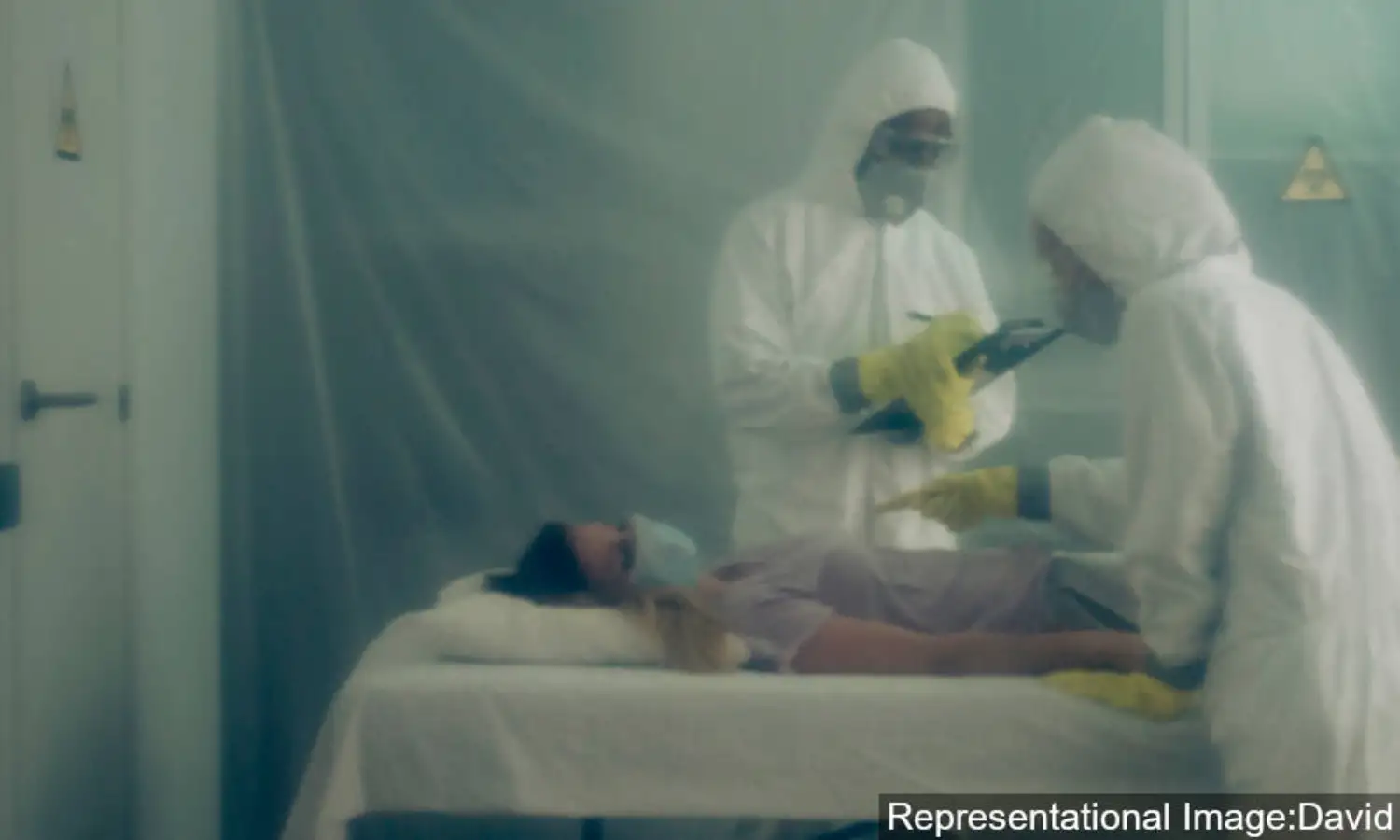கவலையை தரும் ‘அதிக ஆபத்தில்லாத’ நோயாளிகளின் இறப்புகள்

மும்பை:2020 ஏப்ரல் 7ம் தேதி, 25 வயதான ஒருவர்மும்பை ராஜாவடி மருத்துவமனைக்குஅழைத்து வரப்பட்டார். இது, நகரின் கிழக்கு புறநகரில் 596 படுக்கைகள் கொண்ட இரண்டாம் நிலை பராமரிப்பு மையமாகும். கொண்டு வரப்பட்ட இளம் நோயாளிக்கு நாள்பட்ட நோயான சிறுநீரக நோய், நீரிழிவு அல்லது உயர் இரத்த அழுத்தம் போன்ற நோய் பாதிப்புகள் இல்லை; ஆனால் கோவிட்-19 தொற்றுக்கான ‘கொமொர்பிடிடிஸ்’ என்ற அதிக ஆபத்துள்ள பிரிவில் அவர் சேர்க்கப்பட்டார். கோவிட் 19 இறப்பில் அதிகம் பதிவு செய்த மும்பையில், அவர் நாள் முழுவதும் கூட அங்கு இருக்கவில்லை.
இந்தியாவின் நிதி தலைநகரமான மும்பை, கோவிட் 19 பதிவானதன் சதவீதம் 6 ஆக உள்ள நிலையில், இது, நாடு முழுவதற்குமான சராசரி 3.3% உடன் ஒப்பிடும்போது அதிகமாக உள்ளது.
மும்பை நகரில் உறுதிப்படுத்தப்பட்ட கோவிட் 19 நோயாளிகள் 2,120என்ற எண்ணிக்கையானது, கேரளா (395) மற்றும் டெல்லி (1,640) போன்ற பல மாநிலங்களின் எண்ணிக்கையை விட அதிகம்.
ஏப்ரல் 7, 2020 அன்று, 25 வயதான நோயாளி மருத்துவமனைக்கு கொண்டு வரப்பட்ட அதே நாளில், மற்றொரு 45 வயது நபர்சியோன் மருத்துவமனையில் அனுமதிக்கப்பட்டார். இது, அதிகாரப்பூர்வமாக லோக்மண்ய திலக் மருத்துவக் கல்லூரி மற்றும் பொது மருத்துவமனை (எல்.டி.எம்.சி.ஜி.எச்) ஆகும். இது 1,900 படுக்கைகள் கொண்ட மூன்றாம் நிலை பராமரிப்பு மையமாகும். இந்த நோயாளியும் வயதானவர் என்ற பிரிவில் (அதாவது 60 வயது அல்லது அதற்கு மேற்பட்டவர்கள்) வரவில்லை. அவருக்கு எந்தவிதமான குணமாகாத நோய் (கோமர்பிடிட்டி) இல்லை. ஆயினும்கூட, மறுநாள் அவர், உலகளவில் 147,337 பேரையும், இந்தியாவில் 452பேரையும் கொன்ற கோவிட் தொற்று வைரஸுக்கு பலியானார்.
இந்தியாவின் கோவிட்19 வைரஸ் பாதிப்பு எண்ணிக்கை உயர்ந்து வரும் சூழலில், ஆரோக்கியமான நபர்களும் வைரஸால் பாதிக்கப்படுவது வெளிச்சத்து வரத் தொடங்கியுள்ளது. இந்த போக்கு முன்பு சீனாவில் தெரிந்ததாக அறிக்கைகூறுகிறது. அங்கு சில இளம் வயது நோயாளிகளுக்கு வைரஸ் ஏன் ஆபத்தை விளைவித்தது என்பது தெளிவாகத் தெரியவில்லை; மற்றவர்களுக்கு லேசான அறிகுறிகளுக்கு மட்டுமே இது வழிவகுத்தது என்று நிபுணர்கள் சுட்டிக்காட்டினர்.
"இளம் வயதினர் ஏன் பாதிக்கப்படுகிறார்கள் மற்றும் மோசமான விளைவுகளை ஏற்படுகிறது என்பதை நாம் இப்போது தெரிய வேண்டும்," என்று மும்பையை சேர்ந்த தொற்று நோய் நிபுணரும், கோவிட்19 சிகிச்சை நெறிமுறையை உருவாக்கஅமைக்கப்பட்ட குழுவின் உறுப்பினருமான ஓம் ஸ்ரீவாஸ்தவா கூறினார். இந்தியா ஸ்பெண்ட் முன்பு அறிவித்தபடி, இதுவரை மருத்துவர்கள் பொதுவான வழிகாட்டுதல்கள் மற்றும் தங்கள் சகாக்களிடம் இருந்து வரும் கருத்துக்களையே நம்பியுள்ளனர்.
இப்பணிக்குழுவில், தொற்று நோய்கள், காசநோய் (காசநோய்) மற்றும் பொது சுகாதார நிபுணர்கள் உள்ளிட்ட சிறப்பு மருத்துவர்கள் உள்ளனர். "நோய்த்தொற்றின் வடிவத்தைப் பொறுத்தவரை, உலகெங்கிலும் பின்பற்றப்பட்ட நிலையான வகையான வரைபடம் அது [மும்பை] பின்பற்றுகிறது," என்று அவர் கூறினார்.
பாதிக்கப்படும் நோயாளிகளின் வயது, சில மாத வயதுள்ள குழந்தைகள் தொடங்கி, 90 வயதுக்கு மேற்பட்டவர்கள் வரை இருக்கிறது.
மும்பையும் டெல்லியும் தொற்றுநோயை எவ்வாறு கையாள்கின்றன என்பதை கீழ்கண்ட இந்த நேர்காணலைப் பாருங்கள்:
Delhi is admitting all #COVID19 cases, while Mumbai is admitting only the symptomatic ones. How are the two cities managing the pandemic? @govindethiraj speaks to @DrJeenam & @drrajeshchawla on the frontlines. pic.twitter.com/qKZpUzBP91
— IndiaSpend (@IndiaSpend) April 16, 2020
இளைஞர்கள் மத்தியில் ஏற்படும் இறப்புகள், இவ்விஷயங்களை குழப்பமடையச் செய்கின்றன; அவர்களுக்கும் அதிக ஆபத்து இருப்பதாக அரசு நம்புகிறது. இதன் பொருள், நாம் சோதனையை மேலும் விரிவுபடுத்த வேண்டும் என்பதாகும்.
வல்லுநர்கள் அறிவுறுத்தியபடி, சோதனையை அதிகரிப்பதற்கு பதிலாக, மும்பை அதிகாரிகள் அனைத்து நோயாளிகளையும் பரிசோதிக்க இயலாது என முடிவுசெய்துள்ளனர்; சான்றுகள் தெளிவாக இருந்தாலும், அறிகுறிகள் உள்ளவர்கள் மட்டுமே இப்போது சோதிக்கப்படுகிறார்: கோவிட்19 நோயாளிகளில் சுமார் 80%லேசான அறிகுறிகளை கொண்டிருக்கிறார்கள் அல்லது அறிகுறியற்றவர்களாக இருக்கிறார்கள், மேலும் பலரை பாதிக்கலாம்.
உலகெங்கிலும் உள்ள அனுபவத்தின் அடிப்படையில், மும்பையில் இதுவரை கோவிட்19 க்கு ஆளான நோயாளிகளில் 87% பேருக்கு கொமொர்பிடிடிஸ் மற்றும் 7 - 8% பேருக்கு வயது தொடர்பான ஆபத்து காரணிகள் உள்ளன என்று ஏப்ரல் 13, 2020 அன்று மாநகரின் குடிமை அதிகாரிகள் வெளியிட்ட தரவுகள் தெரிவிக்கின்றன; மீதமுள்ளவர்கள் ஆரோக்கியமானவர்கள், இளைஞர்கள்.
உலக சுகாதார அமைப்பு (WHO)மீண்டும் மீண்டும் பரிந்துரைத்தபடி, சோதனையை கணிசமாக அதிகரிப்பது மட்டுமே, ஒரு சமூகத்தில் கோவிட் 19 பாதிக்கப்பட்ட இளைஞர்களின் எண்ணிக்கையை பற்றிய ஒரு யோசனையை நமக்கு வழங்கும்.
"இது கொள்கை வகுப்பாளர்களின் கவனத்தை ஈர்க்க வேண்டுமா, ஆம், ஏனெனில், இது [இளம் வயது நோயாளிகள்] முன்பு இல்லாத தகவல்களாக இருந்தது," என்றார் ஸ்ரீவஸ்தவா. "இந்த அனுபவத்தில் இருந்து நாம் கற்றது இதுதான் என்று சொல்வதற்கு முன் இந்த தகவல்கள் அனைத்தும் உங்கள் வாயிலாகவே வருவது முக்கியம்" என்றார்.
ஆபத்து இல்லாத ஆரோக்கியமான நபர்கள் கோவிட் 19 க்கு ஏன் பலியான்றனர்?
“நோய்த்தொற்றின் எட்டாவது அல்லது ஒன்பதாம் நாளில் இறந்த ஒருவருக்கு எதிராக, நோய்த்தொற்றின் முதல் நாளில் இறந்த ஒருவரையும் நாம் காணும் போது, வைரஸை மட்டுமல்ல, சமூக விலக்கலையும் [உடல் ரீதியான தூரத்தை பார்க்க வேண்டும்] அல்லது கொமொர்பிடிட்டி - இந்த நோயாளிகளின் நோயெதிர்ப்பு அளவுருக்கள் என்ன என்பதை நீங்கள் பார்க்க வேண்டும்” என்றார் ஸ்ரீவாஸ்தவா.
இளைஞர்கள் ஏன் வைரஸால் பாதிக்கப்படுகிறார்கள் என்பதைப் புரிந்து கொள்ள, அவர்களின் நோயெதிர்ப்பு மண்டலத்திற்கு தூண்டுவது என்னவென்று அறிவது முக்கியம், இது நோயாளிகளுக்கு முக்கியமானதாக மாறியது, என்றார் அவர்.
தற்சமயம், வைரஸை பற்றிய நமது அறிவு, மிகவும் ஆபத்தில் உள்ளவர்கள், மற்றும் அது வெவ்வேறு புள்ளிகளை எவ்வாறு பாதிக்கிறது என்பது பற்றிய தகவல்கள் தொடர்ந்து உருவாகி வருகின்றன. சில கோவிட்19 நோயாளிகள் “சைட்டோகைன் புயல்” என்று குறிப்பிட்டு அனுபவிக்கிறார்கள். நோயாளியின் உடல் அதிகளவு புரதங்களை (சைட்டோகைன்)வெளியிடும் போது அதிக வீக்கத்தை ஏற்படுத்துகிறது.
நோய்த்தொற்றுக்கு முன்னர் நோயாளியின் ஒட்டுமொத்த ஆரோக்கியம் போன்ற பல காரணிகள், இதில் செயலாற்றுகின்றன.
"யாருக்காவது காலப்போக்கில் ஊட்டச்சத்து குறைபாடு இருந்தால், அவர்கள் ஆரோக்கியமாக இருக்கக்கூடிய அவசியமில்லை" என்று புனேவின் இந்திய அறிவியல், கல்வி மற்றும் ஆராய்ச்சி நிறுவனத்தின் (IISER) நோயெதிர்ப்பு நிபுணரும் ஆராய்ச்சியாளருமான வினீதா பால் கூறினார். உதாரணமாக, இளைஞர்கள் ஊட்டச்சத்து குறைபாடுள்ள புலம்பெயர்ந்தோரா என்பது முக்கியமல்ல என்று பால் கூறினார்.
யாரோ ஒருவர் பாதிக்கப்படும்போதும் மற்றும் சிகிச்சைக்கும் இடையே உள்ள இடைவெளி முக்கியமானது, அதே போல் ‘வைரஸ் சுமை’ (இரத்தத்தில் உள்ள வைரஸ் துகள்களின்எண்ணிக்கை) கூட, பால் கூறினார். இந்தியாவில் சோதனைகள் தற்போது கோவிட்19 நோய்த்தொற்றுக்கு ஆம் அல்லது இல்லை என்ற பதிலை மட்டுமே தருகின்றன; மேலும் வைரஸ் பாதிப்பை சொல்ல ஒரு கட்டத்தில் இல்லை என்றும் அவர் கூறினார்.
நகரத்தை நன்கு அறிந்தவர்கள், அதிகாரிகள் அதை தங்கள் திறனுக்கு ஏற்றவாறு கையாளுகிறார்கள் என்று நம்புகிறார்கள். "நீங்கள் இதற்கு பதிலளிக்க விரும்பினால் [கோவிட்19], நகர அளவிலான திட்டமிடல் மற்றும் திறனை நீங்கள் கொண்டிருக்க வேண்டும்," என்று மும்பையை சேர்ந்த பிரஜா அறக்கட்டளையின்இயக்குனர் மிலிந்த் மஸ்கே கூறினார், இது நிர்வாகத்தில் பொறுப்புணர்வை அதிகரிக்கச் செய்கிறது. “பிஎம்சி [மும்பையின் குடிமை அமைப்பு] மிகச் சிறப்பாக பதிலளிக்கும் இடங்களில் ஒன்றாகும். மும்பையில் நாங்கள் தீவிரமாக சோதனை செய்கிறோம். நகரத்துடனும், மாநிலத்துடனும் நிறைய ஒருங்கிணைப்பு உள்ளது” என்றார்.
சோதனையை மட்டுப்படுத்தும் முடிவு அந்த பலன்களை தவிர்க்கக்கூடும்.
"தென்கொரியாவில் உள்ளதை போலவே, பெரும்பாலான மக்கள் சோதனைக்கு அணுகலை காண நான் விரும்புகிறேன்" என்று பால் கூறினார். பல ஆண்டுகளாக நமது நாடு பொது சுகாதார அமைப்பை முறையாக நிதி செய்யவில்லை; இப்போது [ஒரு தொற்றுக்கு நடுவில்] இதைப்பற்றி எதுவும் செய்ய முடியாது" என்றார்.
(ஷெட்டி, இந்தியா ஸ்பெண்ட்செய்திப்பணியாளர்).
உங்களின் கருத்துகளை வரவேற்கிறோம். கருத்துகளை respond@indiaspend.org. என்ற முகவரிக்கு அனுப்பலாம். மொழி, இலக்கணம் கருதி அவற்றை திருத்தும் உரிமை எங்களுக்கு உண்டு.


